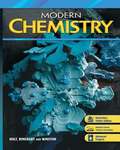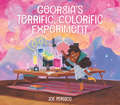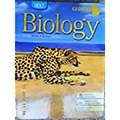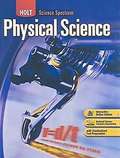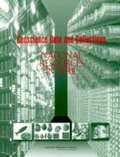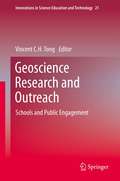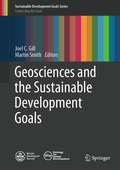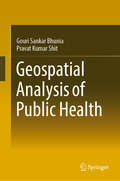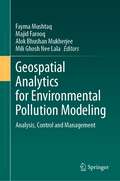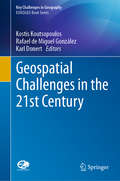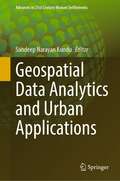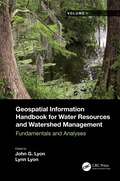- Table View
- List View
Georgia Modern Chemistry
by Jerry L. Sarquis Mickey Sarquis Raymond E. Davis Regina FreyNIMAC-sourced textbook
Georgia Science [Grade 8]
by Dinah Zike Nicholas Hainen Cathy Ezrailson Patricia Horton Deborah Lillie Thomas Mccarthy Eric Werwa Margaret K. ZornTextbook.
Georgia Science: A Closer Look 5th Grade
by Lucy Daniel Joanne Vasquez Jay Hackett Richard Moyer Pamela Stryker H. Prentice BaptisteThis books covers life science, earth science and physical science broadly.
Georgia Science: A Closer Look [Grade 3]
by Dinah Zike Jay K. Hackett Richard H. Moyer Joanne Vasquez Mulugheta Teferi Kathryn LeroyNIMAC-sourced textbook
Georgia Science: A Closer Look [Grade 4]
by Dinah Zike Jay K. Hackett Richard H. Moyer Joanne Vasquez Mulugheta Teferi Kathryn Leroy Dorothy J. T. Terman Gerald F. WheelerNIMAC-sourced textbook
Georgia Science: A Closer Look, Standards Test Preparation for CRCT [Grade 2]
by Mcgraw HillNIMAC-sourced textbook
Georgia Science: A Closer Look, Standards Test Preparation for CRCT [Grade 3]
by Mcgraw HillNIMAC-sourced textbook
Georgia Science: A Closer Look, Standards Test Preparation for CRCT [Grade 5]
by Mcgraw HillNIMAC-sourced textbook
Georgia Science: A Closer Look, Standards Test, Preparation for CRCT [Grade 1]
by Mcgraw HillNIMAC-sourced textbook
Georgia's Terrific, Colorific Experiment
by Zoe PersicoScience and art come together in this colorful and empowering picture book about a strong minded girl scientist and her artist family. Is it possible for science and art to really mix?Georgia wants to be a scientist, and a great one at that. But in order become a great scientist, she must first create her own, unique experiment. Her mother, father, grandma, and brother all want to help, but they're artists. How could they possibly help her with science? Everyone knows art and science just don't go together!As Georgia struggles to create her unique experiment, she eventually learns that sometimes science, too, can be a work of art.
Georgia: Biology
by The National Geographic Society Alton Biggs Dinah Zike Whitney Crispen Hagins William G. Holliday Chris L. Kapicka Linda Lundgren Ann Haley Mackenzie William D. Rogers Marion B. SewerNIMAC-sourced textbook
Geoscience Data and Collections: National Resources in Peril
by National Research CouncilGeoscience data and collections (such as rock and sediment cores, geophysical data, engineering records, and fossils) are necessary for industries to discover and develop domestic natural resources to fulfill the nation's energy and mineral requirements and to improve the prediction of immediate and long term hazards, such as land slides, volcanic eruptions, and global climate change. While the nation has assembled a wealth of geoscience data and collections, their utility remains incompletely tapped. Many could act as invaluable resources in the future but immediate action is needed if they are to remain available. Housing of and access to geoscience data and collections have become critical issues for industry, federal and state agencies, museums, and universities. Many resources are in imminent danger of being lost through mismanagement, neglect, or disposal. A striking 46 percent of the state geological surveys polled by the committee reported that there is no space available or they have refused to accept new material. In order to address these challenges, "Geoscience Data and Collections offers a comprehensive strategy for managing geoscience data and collections in the United States.
Geoscience Research and Outreach: Schools and Public Engagement
by Vincent C. TongFrom energy and water resources to natural disasters, and from changing climatic patterns to the evolution of the Earth's deep interior, geoscience research affects people's lives in many ways and on many levels. This book offers a stimulating cross-disciplinary perspective on the important relationship between geoscience research and outreach activities for schools and for the general public. The contributors - academics, research scientists, science educators and outreach program educators - describe and evaluate outreach programs from around the world. A section entitled Field-based Approaches includes a chapter describing an initiative to engage Alaskan communities and students in research, and another on problem-based learning in the field setting. The Online Approaches section discusses ways to connect students and scientists using online forums; use of the web and social media, including the United Nations University and its experience with the design of a web magazine featuring geoscience research; and video clips on marine geoscience created by students and scientists. The section on Workshop and Laboratory-based Approaches includes a chapter on teaching geochronology to high school students, and another describing an extracurricular school activity program on meteorology. The Program Design section presents chapters on Integrating Geoscience Research in Primary and Secondary Education, on ways to bridge research with science education at the high school level, and on use of online geoscience data from the Great Lakes. The concluding section, Promoting Research-enhanced Outreach, offers chapters on Geoscience Outreach Education with the local community by a leading research-intensive university, and on the use of research to promote action in Earth science professional development for schoolteachers.Geoscience Research and Outreach: Schools and Public Engagement will benefit geoscience researchers who wish to promote their work beyond academia. It offers guidance to those seeking research funding from agencies, which increasingly request detailed plans for outreach activities in research proposals. Policymakers, educators and scientists working in museums, learned societies and public organizations who wish to widen participation will also find this book useful. Together with the companion volume Geoscience Research and Education: Teaching at Universities, this book showcases the key role that geoscience research plays in a wide spectrum of educational settings.
Geosciences and the Sustainable Development Goals (Sustainable Development Goals Series)
by Martin Smith Joel C. GillMeeting the targets of the UN Sustainable Development Goals (SDGs) requires contributions by scientists focusing on understanding, monitoring, protecting, managing and restoring the natural environment, including geoscientists. This book presents the first detailed discussion on the role of the geological sciences (geosciences) community in the implementation of the SDGs. Unlike traditional geosciences textbooks, it is structured according to development priorities, framed in the context of the 17 SDGs. Written by international experts from diverse range of geosciences / development disciplines, it explores themes linked to both science and the professional practice of science (e.g., ethics, equity, conduct, and partnerships). The book is intended for graduate and senior undergraduate students in the earth sciences, as well as practicing geologists and experts from other sectors involved in sustainability initiatives.
Geospatial Analysis of Public Health (Global Perspectives on Health Geography)
by Gouri Sankar Bhunia Pravat Kumar ShitThis book is specifically designed to serve the community of postgraduates and researchers in the fields of epidemiology, health GIS, medical geography, and health management. It starts with the basic concepts and role of remote sensing, GIS in Kala-azar diseases. The book gives an exhaustive coverage of Satellite data, GPS, GIS, spatial and attribute data modeling, and geospatial analysis of Kala-azar diseases. It also presents the modern trends of remote sensing and GIS in health risk assessment with an illustrated discussion on its numerous applications.
Geospatial Analytics for Environmental Pollution Modeling: Analysis, Control and Management
by Majid Farooq Fayma Mushtaq Alok Bhushan Mukherjee Mili Ghosh Nee LalaThis book aims to provide a comprehensive study on various aspects of environmental pollution dynamics using geospatial technology and modeling techniques. The utility of geospatial technology will be demonstrated for the effective study of environmental pollution, as space and location are very important for effective environmental health surveillance. The timeliness of the work is due to the increasing relevance of geospatial technology applications in environmental health investigations. Moreover, different types of pollution are covered in detail, including air and soil, all of which are analyzed using latest Remote Sensing and GIS technology. The basics of environmental pollution and its impacts are covered in the book's first part, while the second part focuses on the use of geospatial technology in investigating and modeling various instances of environmental pollution. The third part discusses policy measures for mitigating environmental pollution hazards, using geospatial analyses and data to craft informed policy decisions. The primary audience for the book is researchers working in the field of environmental pollution with incorporation of geospatial technology, including upper-level undergraduate and graduate students taking courses in remote sensing and its environmental applications. The secondary audience is academicians, planners, environmentalists and policymakers working in the field of environment protection and management.
Geospatial Challenges in the 21st Century (Key Challenges in Geography)
by Rafael de Miguel González Kostis Koutsopoulos Karl DonertThis book focuses on 21st century geospatial technologies (GT). It highlights their broad range of capabilities and their essential role in effectively addressing and resolving critical everyday issues, such as environment, sustainability, climate change, urban planning, economy, culture and geopolitics. Featuring chapters written by leading international scientists, it discusses the application of GT tools and demonstrates that the problems requiring such tools transcend national boundaries, cultures, political systems and scientific backgrounds on a global scale. In addition, it enhances readers’ spatial understanding of, and geographical reasoning in connection with, societal issues. The book will appeal to scientists, teachers and students of geography, the earth sciences and related areas, as well as decision-makers interested in the application and capabilities of geospatial technologies and new, spatial methods for addressing important issues.
Geospatial Data Analytics and Urban Applications (Advances in 21st Century Human Settlements)
by Sandeep Narayan KunduThis book highlights advanced applications of geospatial data analytics to address real-world issues in urban society. With a connected world, we are generating spatial at unprecedented rates which can be harnessed for insightful analytics which define the way we analyze past events and define the future directions. This book is an anthology of applications of spatial data and analytics performed on them for gaining insights which can be used for problem solving in an urban setting. Each chapter is contributed by spatially aware data scientists in the making who present spatial perspectives drawn on spatial big data. The book shall benefit mature researchers and student alike to discourse a variety of urban applications which display the use of machine learning algorithms on spatial big data for real-world problem solving.
Geospatial Information Handbook for Water Resources and Watershed Management, Volume I: Fundamentals and Analyses
by Lyon John G.Volume I of Geospatial Information Handbook for Water Resources and Watershed Management discusses fundamental characteristics, measurements, and analyses of water features and watersheds including lakes and reservoirs, rivers and streams, and coasts and estuaries. It presents contemporary knowledge on Geospatial Technology (GT)–supported functional analyses of water runoff, storage and balance, flooding and floodplains, water quality, soils and moisture, climate vulnerabilities, and ecosystem services. Captures advanced Geospatial Technologies (GTs) addressing a wide range of water issues Provides real-world applications and case studies using advanced spectral and spatial sensors combined with geospatially facilitated water process models Details applications of ArcInfo/ArcGIS, Google Earth Engine, and other systems using advanced remote sensors, including hyperspectral ER2 AVIRIS, Sentinel-1 and -2, MODIS, Landsat 7 ETM+, Landsat 8 OLI and TIPS, SAR radar, and thermal imaging Global in coverage with applications contributed by more than 170 authors with lifelong expertise in water sciences and engineering This handbook is a wide-ranging and contemporary reference of advanced geospatial techniques used in numerous practical applications at the local and regional scales and is an in-depth resource for professionals and the water research community worldwide.

